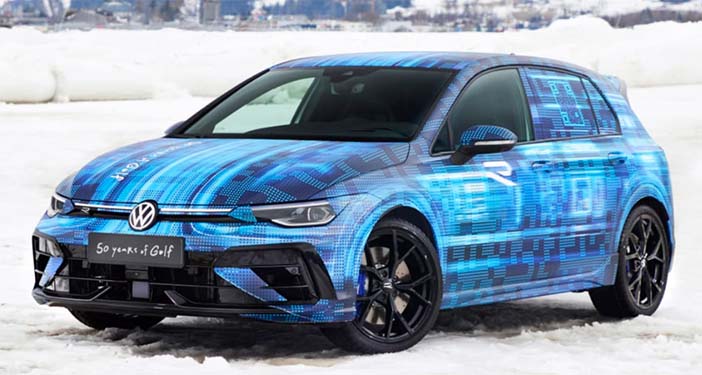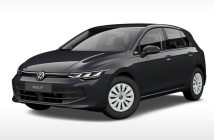+++ The first new ASTON MARTIN model of 2024 is around the corner. The company will unveil the next-generation Vantage in February, and it published a preview image to give us an idea of what it has in store. It also announced plans to take the model racing around the globe. While some carmakers give new models a new name, Aston Martin is staying close to its heritage: the Vantage’s replacement will be called Vantage, just like the outgoing Vantage replaced the last-generation Vantage. The preview image shows that the fenders get a deeper vent that’s split by an “Aston Martin” emblem, and the current car’s clamshell hood disappears. We’ll need to be patient to see more of it. Earlier spy shots hint at redesigned headlights that bring the Vantage in line with the DB12 unveiled in 2023: a new-look grille and reshaped taillights. The model will again be available as a coupe and as a Volante-badged convertible. We’re also, of course, curious to find out what it shares with its predecessor under the sheet metal. Power for the current Vantage comes from a version of the twin-turbocharged, 4.0-liter V8 built by Mercedes-AMG and tuned in-house to send 510 hp to the rear wheels. My crystal ball tells me the V8 will return with more power, though this is just an educated guess. Aston Martin is done with V12s, so don’t expect the 12-cylinder model to come back. Aston Martin will lift the veil off of the new Vantage on February 12, and enthusiasts are getting a three-for-one deal. On that same day, the brand will also present the GT3-specification version of the coupe and the AMR24 car it will enter in the 2024 season of Formula One. +++
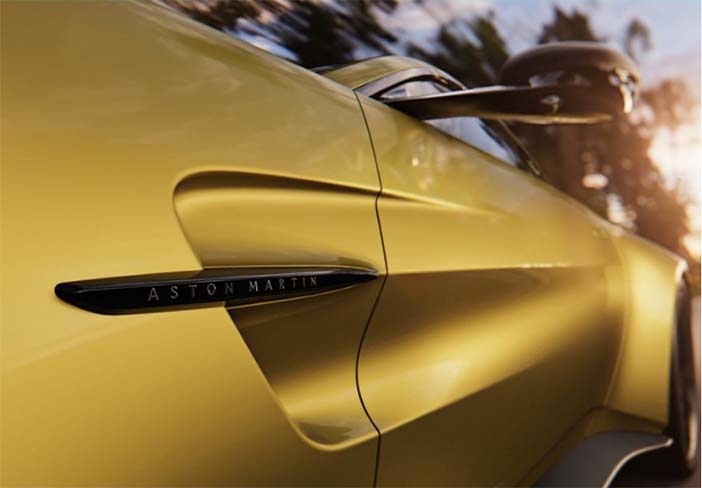
+++ Whatever happened to Ultra CRUISE , GM’s hands-free driving assistance tech intended to be a step above Super Cruise? 3 years after rolling out Super Cruise on the Cadillac CT6 in 2017, a General Motors vice-president spoke of a product called Ultra Cruise that “would be all of the Super Cruise plus the neighborhoods, city streets and subdivisions. So Ultra Cruise’s domain would be essentially all driving, all the time”. The qualifier “essentially” was clarified a year later to mean 95% of normal driving situations whenever the technology launched. To start, the system was planned to be compatible with more than two million miles of U.S. and Canadian roads and expand from there. Originally, Ultra Cruise would be GM’s competitor for Tesla’s Full Self Driving, separated by price point like any other luxury feature (Tesla’s FSD costs $12.000 compared to Enhanced Autopilot’s $6.000). The vice-president said: “The combination of Ultra Cruise for premium offerings and Super Cruise for lower-cost products will enable us to offer driver-assist technology across price points and segments”. Then, essentially, crickets, until a CNBC report this month that stated, “2 sources familiar with the system told that the automaker is ending the Ultra Cruise program. 1 source said GM has decided to instead focus on the current Super Cruise system and expanding its capabilities rather than having 2 different, similarly named systems”. Considering GM’s (and the industry’s) challenges with electric vehicles and EV technology, and GM’s issues with a different kind of Cruise (GM’s autonomous car development division), the CNBC piece could have given the idea that the automaker was walking back ambitious goals for driver assistance tech and a face-off with Full Self Driving. That’s not the case. GM explained to a number of outlets that nothing substantial has changed except the name; that is, instead of 2 teams working on 2 hands-free systems, one more capable than the other, GM’s putting its money into expanding what Super Cruise can do. GM never provided a date for Ultra Cruise’s rollout. The automaker’s already working on the soft points of expanded hands-free driving, launching a public awareness and dealership instruction campaign last July called “Hands Free, Eyes On”, trying to get vehicle owners to understand the limits of the tech. The closest we got for Ultra Cruise availability was GM saying the $340.000 Cadillac Celestiq would be the first product so equipped. Even with that, we were told Ultra Cruise wouldn’t be available at the electric sedan’s launch, instead being ladled into the Celestiq’s tech suite via OTA updates. As far as we can tell, the Celestiq is getting the same Super Cruise found in other GM products. Based on the Super Cruise’s current capabilities of more than 640.000 km of roads in the U.S. and Canada, and Ultra Cruise’s aim of more than 3.2 million km (that include the hardest kind to drive, city kilometers) there could be a long road and a lot of updates to get from the former to the latter. And that makes sense: better get it right. +++
+++ GENERAL MOTORS shares jumped Tuesday after the company gave investors an upbeat outlook for 2024 and signaled more capital will be returned to shareholders. “Consensus is growing that the U.S. economy, the job market and auto sales will continue to be resilient”, GM Chief Executive Mary Barra told investors in a letter. GM expects to reduce shares outstanding to below 1 billion, down from about 1.2 billion currently and 1.6 billion at the post-IPO peak, Barra said. Barra highlighted moves to return cash to shareholders, including $12 billion in 2023 through a $10 billion share buyback and a 33% dividend increase. “We are prioritizing returning cash to our shareholders”, Barra said. GM’s 2024 forecast calls for $8 billion to $10 billion in free cash flow, nearly all of it generated by GM’s internal combustion engine, or ICE, vehicles. “The ICE machine is up and working again. Please proceed to the end of the hallway and fill your buckets!” Evercore ISI analyst Chris McNally wrote in a note. GM is pinning hopes on strong demand for its combustion trucks and SUVs in North America, cost-cutting and increasing sales of its new generation of electric vehicles after 2023 deliveries fell short of earlier plans. GM expects overall EV sales will rise this year to 10% of the U.S. market from 7% in 2023. “We know the EV market is not going to grow linearly”, CFO Paul Jacobson told analysts. “We are prepared to flex between ICE and EV production”. However, Barra said GM will launch plug-in hybrid vehicles in North America, a turn away from a strategy of bypassing hybrid powertrains in that market. U.S. hybrid sales have been rising as consumers balk at high EV prices and recharging infrastructure challenges. “We are timing to launches to help us comply with the more stringent fuel economy and tailpipe emission standards that are being proposed”, Barra said. “And we plan to deliver the program in a capital and cost efficient way because the technology is already in production in other markets. We’ll have more to share about this down the road”. Analysts questioned Barra about potential shifts in GM’s money-losing EV and self-driving vehicle strategies, as well as declining sales in China. “We’re not going to shy away from making tough calls” to protect profitability, Barra said. “Nothing is off the table”. GM will delay an investor day planned for March until later this year “because of the significant changes that are underway at GM and Cruise”. Barra said. GM also wants more time to resolve software development problems that have forced the company to stop selling its new Chevrolet Blazer EV. GM expects its electric vehicle operations will begin returning variable profit by the second half the year, Jacobson said. It forecast 2024 adjusted pre-tax profits of $12 billion to $14 billion, compared to $12.4 billion reported for 2023. GM will hold capital spending roughly flat. The 2024 forecast translates to between $8.50 and $9.50 a share, compared to $7.68 in 2023. Fewer shares due to buybacks adds $1.45 a share to the forecast. That will be offset by higher taxes and interest payments. Cost-cutting will play a big role in hitting forecasts, as GM expects vehicle prices to drop. GM plans to cut $400 million from marketing spending, on top of $500 million cut last year, Jacobson said. Engineers have cut $200 million from product development costs, Barra said. For the 4th quarter, GM reported net income rose 5.2% to $2.1 billion on revenues of $43 billion. Adjusted pre-tax profit fell by 54% to $1.8 billion. The decrease reflected the impact of last fall’s United Auto Workers’ strikes, higher costs at Cruise and a $1.1 billion writedown related to EV battery cells held in inventory, the company said. Spending at the troubled Cruise robo-taxi unit will be cut by $1 billion. Cruise halted operations after one of its self-driving cars dragged a woman down a San Francisco street. Barra said GM will “refocus and relaunch Cruise” without disclosing a timetable. Cruise lost $2.7 billion in 2023, not including $500 million in restructuring costs incurred in the 4th quarter as the unit cut staff. Separately, GM faces deepening challenges in China, once its largest market. Domestic automakers and Tesla are gaining share with electrified vehicles, fresh infotainment technology and aggressive price cutting. GM expects to post a China loss for the current quarter, Jacobson said. “We have a lot of inventory we are working through in first quarter” in China, he said. +++
+++ There’s a chance a flagship sports car emerges from HONDA ’s new 0 Series of battery-electric vehicles introduced at the Consumer Electronics Show. And seeing how the 0 Series already has a defined shelf life, starting with a debut model on the market by 2026 and a sunset around 2031, we suspect the first couple of years of that window would be ideal for a sports car launch. Honda CEO Toshihiro Mibe never confirmed a sports car. He did, however, say that the R&D department already has a prototype, development work is “steadily proceeding”, the business-case people are studying the market, and that “personally, I would like to make it happen”. The report says this potential performance car would be kin with the “distinct character” and cyberpunk shapes of the 2 CES concepts, the Saloon concept (pictured) and the Space Hub concept. After that, Mibe said, “The first priority of making these kinds of cars is that they need to be fun to drive, no matter what powertrain they use”. It’s far too early to try to figure out where such a vehicle might emerge from the nebula of rumor, hope, and hype around Honda’s sports car intentions. The automaker’s made public comments about an electric or a hybrid for at least 13 years; the same Mibe who’s now CEO said in 2011 when he was R&D chief, “President Ito has already mentioned a new NSX, and we have looked at that in the R&D department. It would be an interesting project: electric or hybrid vehicles can be fun as well as economical”. Honda promised an electric third-generation NSX in 2021. Almost exactly a year later, Honda teased 2 electric sports cars that enthusiasts figured could be a new NSX and a new S2000. In 2022, Acura again spoke of a new NSX EV, and in 2023, teased a concept called the Performance Electric Vision Concept that sure looked like an NSX design study. 2 months later, Honda showed a Prelude concept at last year’s Japan Mobility Show, but that was a hybrid and possessed nothing of the “completely different taste” that Mibe mentioned a 0 Series sports car would convey. I wouldn’t be surprised if Honda hasn’t decided on anything yet: the automaker takes its deliberations seriously. At the same time Mibe made comments on the NSX, he said, “We are now at a point where we can consider the next generation of electric and hybrid vehicles”. All we’ve seen for EVs in 13 years was the 1-year-only Jazz EV, the California-only Clarity FCEV, the short-lived Europe-only Honda E and the not-to-be-repeated Honda Prologue. On the other hand, in our report on 5 things we learned about the 0 Series lineup, one was that there might be a debut vehicle before the Saloon-based production car arrives in 2026. Mibe emphasized at CES that the 0 Series is about reimagining the EV, saying, “The mobility we dream of is not an extension of the trend of ‘thick, heavy, but smart’ EVs. We will create a completely new value from zero based on thin, light and wise as the foundation for our new Honda 0 EV Series”. That is a tantalizing description of an electric performance car. Come on, Honda. +++
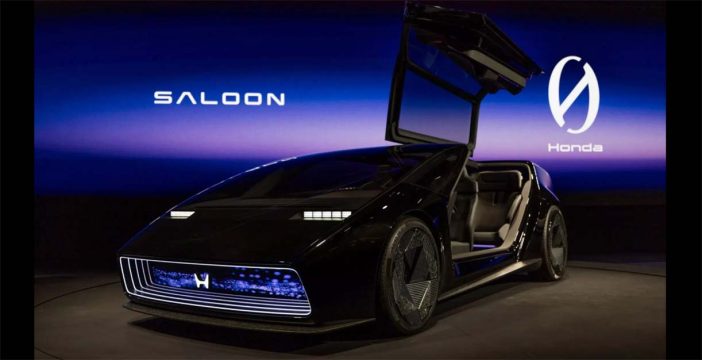
+++ HYUNDAI and KIA outperformed Mercedes-Benz and BMW in record earnings. Both Korean brands recorded sales of $196.2 billion and an operating profit of $20 billion last year, marking their best performance since the companies were founded. Notably, the firms achieved a significant milestone with their operating margin, a critical measure of profitability, reaching double digits for the first time at 10.2%. This figure surpasses Tesla’s operating profit margin of 9.2% from last year and matches the margins of luxury automakers like BMW and Mercedes-Benz. In the broader context, this success fills a gap left by another Korean giant, Samsung Electronics, which experienced its worst performance since 2008. In the automotive industry, it is uncommon for a company to achieve an operating profit exceeding $20 billion. To put this in perspective, in the years 2021-2022, Toyota, the world’s leading automaker, reported annual profits of 2.7 trillion yen, while Volkswagen Group, ranked second, recorded annual profits exceeding 20 billion euros for 2 consecutive years. Achieving double-digit profit margins while selling 7.3 million vehicles is rare. During 2021-2022, Toyota and Volkswagen reported 8-9% operating margins. In contrast, Tesla, BMW and Mercedes-Benz, known for maintaining double-digit margins for years, have global sales figures of around 2 million units. A Korean automotive industry insider noted: “Last year, Toyota’s performance was likely similar or slightly better than Hyundai and Kia’s, owing to the weak yen. Furthermore, Kia’s operating margin of 11.6% could be the highest globally”. The company’s diversified vehicle range beyond electric vehicles (EVs) is the primary driver behind this record-breaking performance. While the EV market, often heralded as the future of transportation, has experienced a slowdown, there are ample ‘alternatives’ like hybrids and SUVs. The efficient production and high pricing of these alternatives, coupled with cost competitiveness, are also critical factors in this success. +++
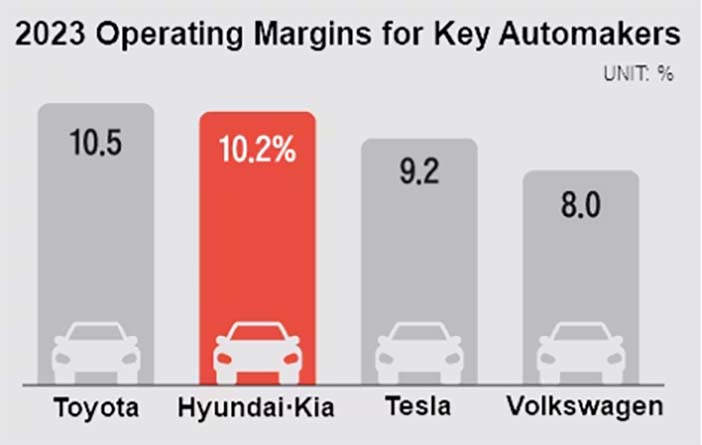
+++ RIVIAN has announced it plans a “worldwide product launch event” on March 7. The question for Rivian watchers, of course, is: what’s going to be shown at the worldwide launch? The marquee product is expected to be the smaller R2 in SUV-styled R2S form. Company CEO RJ Scaringe teased the less expensive model during an Instagram Q&A last May; the image below is a screengrab from the event. The R2 is said to be sized about like the Jeep Grand Cherokee, starting prices thought to be in the €70.000 range (Dutch pricing). Back then, the R2 wasn’t scheduled to be delivered until sometime 2026, though, delayed from the original plans for 2025. If the R2 shows up in the California sun in 2 months, it could be merely as an opener for a long reservation period. Rivian might also introduce high-powered versions of the R1T and R1S. Prototypes with 1.000 hp were rumored to lift their front wheels off the pavement during hard launches. We don’t need to guess about big moves Rivian’s made in the executive suites. In the past couple of months, Rivian’s added ex-Stellantis North America COO Carlo Materazzo, ex-Mercedes-Benz plant manager Arnehelm Mittlebach, and ex-Porsche and Apple mobility veteran Jonas Reinke. It’s shaping up to be a big year. +++
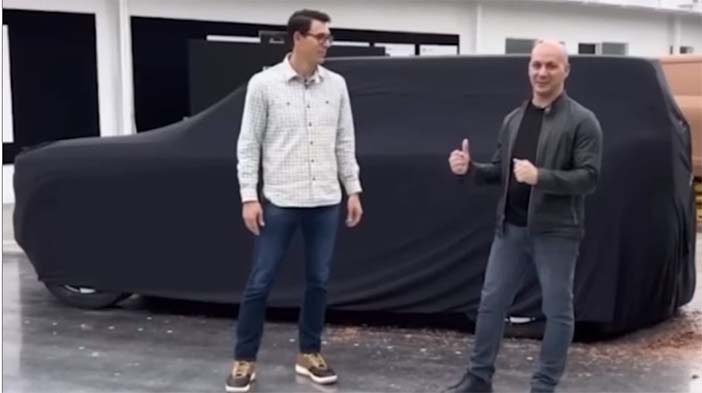
+++ Back in 2010, Elon Musk predicted that Japan would become TESLA ’s largest market outside of the U.S. But more than a decade later, the EV maker isn’t doing as well in the country as Musk had hoped. “There are some geographies where our market share is remarkably low, like Japan”, Musk said in a 4th-quarter earnings call last week. “We should at least have a marketshare proportionate to, say, other non-Japanese carmakers like Mercedes or BMW, which we do not currently have”, he added. But while Tesla is already up against major Japanese carmakers like Toyota, Honda, Suzuki and Nissan, the reality is that all EV makers are struggling to make an impact in Japan. EV sales have soared in recent years in the U.S. and Europe, but Japan has been slow to sell all-electric cars, despite being one of the world’s biggest auto markets. One reason for this is that hybrids have tended to dominate the Japanese market: sales of these cars beat out the combined share of gasoline and diesel cars for the first time in 2023. “In Japan, hybrids are popular because they’re affordable and reliable, since they don’t rely on the existence of strong charging infrastructure”, auto analyst Tatsuo Yoshida said. And leaders appear reluctant to pivot away from this strength to battery-powered alternatives. Toyota’s chairman and the head of Japan’s automotive association, Akio Toyoda, has previously accused the Japanese media of exaggerating the commercial and environmental advantages of EVs, calling the benefits a “mirage”. That hesitancy has also held back the development of charging infrastructure (there are only about 30.000 EV charging connectors in the whole country) and kept price tags higher. But Japanese carmakers do have some plans to boost their EV efforts. Toyota has said it will roll out 30 battery electric vehicle models by 2030 while Honda wants EVs and hydrogen fuel cell cars to make up 100% of sales by 2040. +++
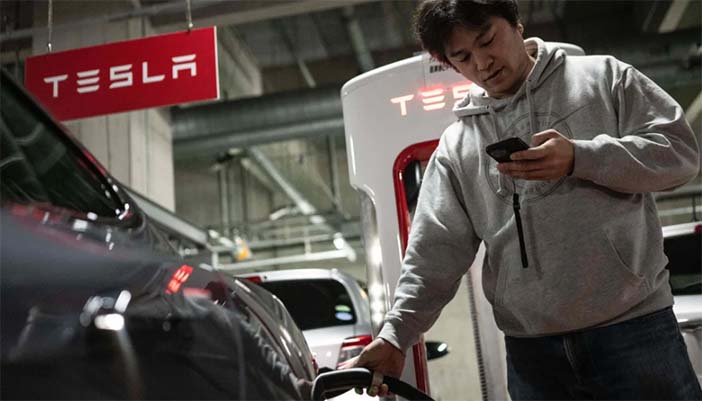
+++ More U.S. households are considering an EV purchase than many people likely expect, but the path forward for battery-powered vehicles isn’t all smooth. A new study from GBK Collective found that half of potential car buyers are considering an EV or hybrid, but the data also revealed that the other half are committed to petrol cars, while most are concerned about purchase and operating costs. TOYOTA was the most-considered automaker among both internal combustion and electric buyers, with Honda taking the second spot among all buyers and Tesla coming in second among EV buyers. Ford, Honda and Chevrolet were the next most considered brands. Beyond Tesla, however, upstart EV makers are having trouble breaking through into the mainstream. GBK surveyed more than 2.000 consumers and found that, while automakers have so far targeted tech-savvy buyers and early adopters, more mainstream buyers are considering an EV purchase. That said, budget-conscious buyers will become a larger portion of shoppers, so EV prices will become a larger issue going forward. Interestingly, GBK’s data showed that potential EV buyers would pay up to $7.650 more than petrol-vehicle buyers. Around 14 percent of households currently own a hybrid or PHEV, while just 3 percent own EVs, but GBK believes the next round of buyers will change that. New EV buyers are more concerned about their environmental impacts than existing owners, while people considering hybrid cars are interested in lowering their ownership and operation costs. Tax incentives also played a role, with 47 percent saying it was a primary reason for looking at EVs. People considering an EV or hybrid aren’t straying far from the overall attitude of the U.S. car market, however. GBK found that many prefer SUVs in neutral colors, similar to buyers on the gas side of the coin. Cost will remain a top factor in buyers’ minds going forward, though, and overall operating costs are a part of the equation. People want to know that the EV they buy won’t need a battery replacement or costly repairs down the road. +++
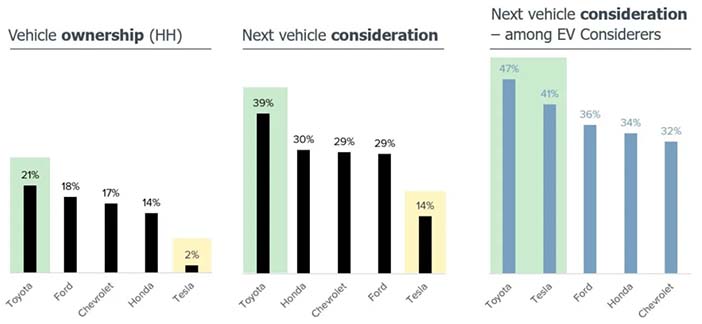
+++ VOLKSWAGEN has got a new teaser for you. During the annual ice races at Zell am See in Austria, VW parked a refreshed Golf GTI in the digital blue camo scheme the automaker favors of late for public reveals of prototypes. However, the quick giveaway for the R is the blue brake calipers instead of the red units on the GTI, and the plump wing atop the hatchback. I imagine telltale differences in the rear will carry over, those being 4 exhaust outlets on the Golf R as opposed to 2 outlets on the GTI. We don’t have to guess about the front, where the hexagonal mesh and the fog lights on the GTI are replaced by a single line through the lower intake and, and angled strakes that frame a radar unit not seen on the other car. Compared to the current Golf R, this look up front is less ornate, more focused. Or, combined with the omission of a manual transmission, maybe the phrase I’m looking for is “more mature”. I hope VW plans more potency for the turbocharged 2.0-liter four-cylinder powertrain. The refreshed GTI gained roughly 20 horses, going from 245 to 265 in European spec. I expect the facelifted Golf R to boast at least 333 hp. +++
